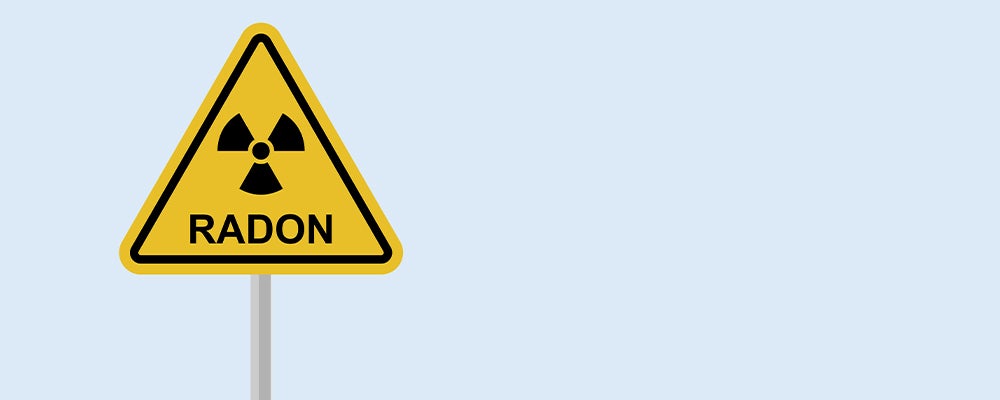
In 2019, an updated study by the same group found approximately one in seven Calgary homes exceeded the Canadian guideline, up considerably from only two years prior.
The University of Calgary published a 2021 article stating:
"Given the scale of the problem, and with the same trends found across every Canadian province and territory, the team calls for proactive radon mitigation systems to be included in all new residential properties constructed using the 2025 Building Code".
Dr. Aaron Goodarzi, Ph.D., the Canada Research Chair for Radiation Exposure Disease and University of Calgary associate professor in the Cumming School of Medicine, is also concerned.
We can't afford to wait. The lives of tens of thousands of Canadians are on the line here, not to mention tremendous amounts of healthcare dollars that we will never need to spend if we work toward prevention today". -Dr. Aaron GoodarziWhat is radon gas?
Radon is a naturally occurring, radioactive gas that is odourless, colourless, and tasteless, so by all accounts, it is virtually undetectable. It is produced by the breakdown of uranium found in sediment (soil), rocks, and water. When radon is released into the atmosphere, it gets diluted and poses little to no risk to human health. That said, if radon accumulates inside a home, it can pose serious health risks to occupants.
What are the dangers of excessive indoor radon levels?
When left unattended, high radon levels in a home can create severe long-term health risks for residents. When inhaled, radon gas particles remain in lung tissue - over time, cell damage caused by radon can lead to the development of lung cancer. Radon is the second leading cause of lung cancer, and it is estimated that 16% of lung cancer deaths among Canadians are linked to indoor radon exposure.
How do I know if there is radon in my home?
Determining if you/your home are at risk is not an easy process. Health Canada advocates long-term tests (performed over three months or longer) to get the most accurate measure of indoor radon. While it sounds daunting, radon testing is relatively inexpensive and can be done by homeowners. Radon levels can be surprisingly different from house to house. Even adjacent homes can have drastically different radon levels. For this reason, Health Canada recommends all homes be tested, regardless of the age of the home.
How does radon enter a home?
Radon can sneak into your home in a few different ways, such as through cracks in the foundation walls and/or floor slabs or other openings, including but not limited to:
- unfinished floors (dirt)
- construction joints
- gaps around service pipes
- support posts
- windows
- floor drains
- water supply
- fireplaces
- pipe entrances
- basement sump pumps
- cracks in solid floors
- cracks in the walls
- cavities inside walls
The soil type, soil moisture level, seasonal freezing/thawing activity, and the home's design can also play a part in letting in radon.
But I live in a new home, am I safe?
Several studies confirm new homes can also have high levels of radon. Sometimes, new builds are constructed with radon-resistant features, but that does not guarantee that a low indoor radon level won't persist. Testing is recommended in all properties to ensure that systems are functioning correctly. When new homes are first occupied, homeowners should conduct a long-term radon test. Sometimes, this may even be covered under a new home warranty program.
How do I get my home tested?
Testing your home for radon is relatively easy and inexpensive, and Health Canada highly recommends that homeowners take the necessary steps to ensure that they are not at risk. There are two options: you can purchase a do-it-yourself kit or hire a professional.
DIY kits include instructions on properly executing the test and submitting the results for professional analysis. Test kits can be purchased by phone, online, or from several home improvement retailers and generally cost between $25-$75 - well worth the investment.
It's worth noting there are short-term and long-term tests available. Most experts will recommend purchasing long-term tests due to their reliability. Long-term tests take readings within the home for 90+ days, and since radon levels can fluctuate daily, they will give a more accurate result. Another University of Calgary study showed "short-term kits were imprecise up to 99 percent of the time when compared to a long-term test".
What do I do if my home shows high indoor radon levels?
If indoor radon levels in your home exceed safe levels, remedial measures are available and vary based on the type of home and its location. The higher the radon level, the sooner you should take action.
Excessive radon levels can be successfully mitigated in every type of home! However, it is best to consult a professional to determine the best course of action for your home.
For more resources, we suggest checking out these links:




